NVIDIA Optimus - Truly Seamless Switchable Graphics and ASUS UL50Vf
by Jarred Walton on February 9, 2010 9:00 AM ESTASUS UL50Vf Battery Life and Power
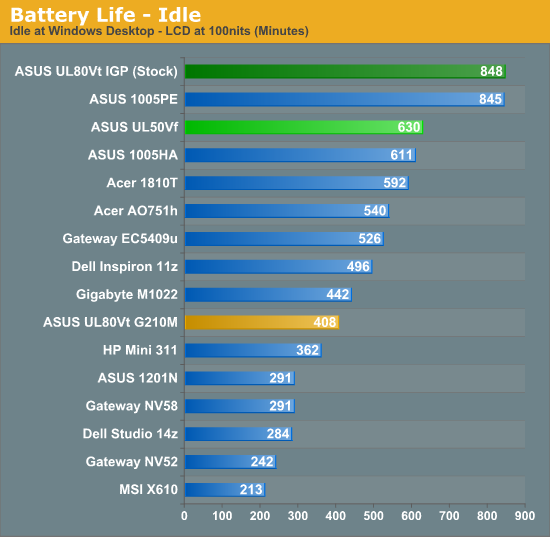
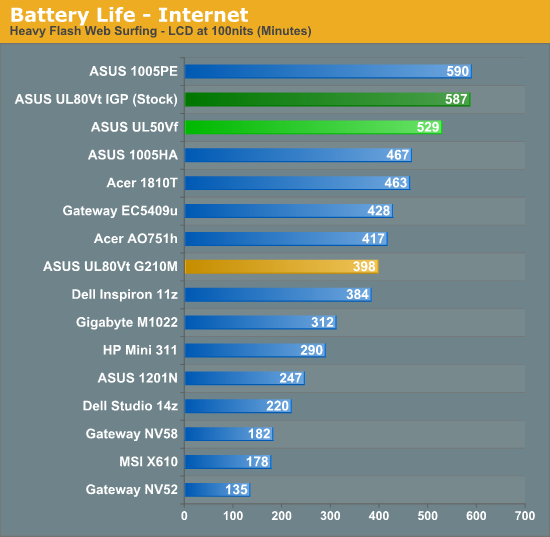
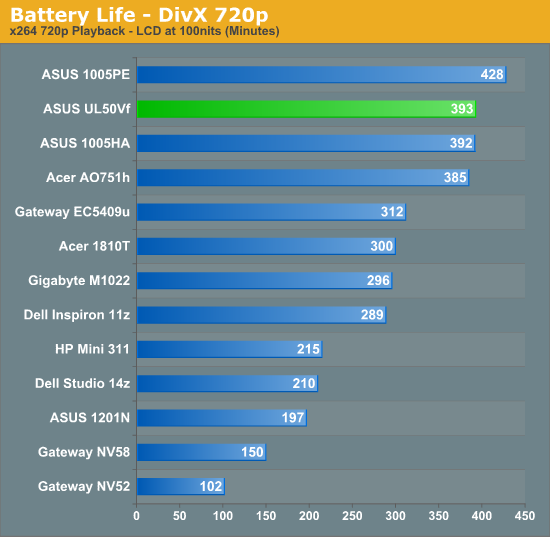
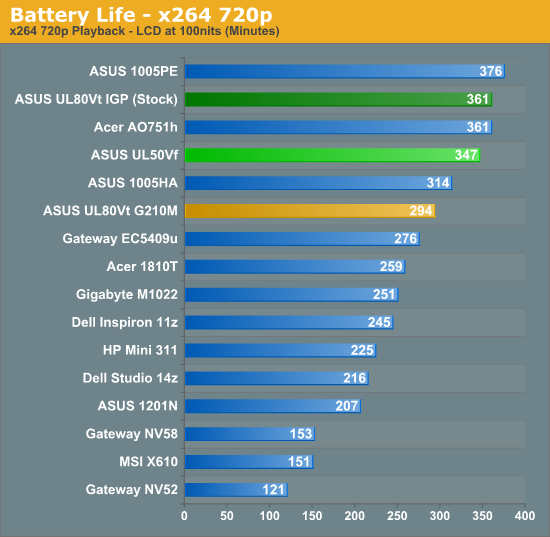
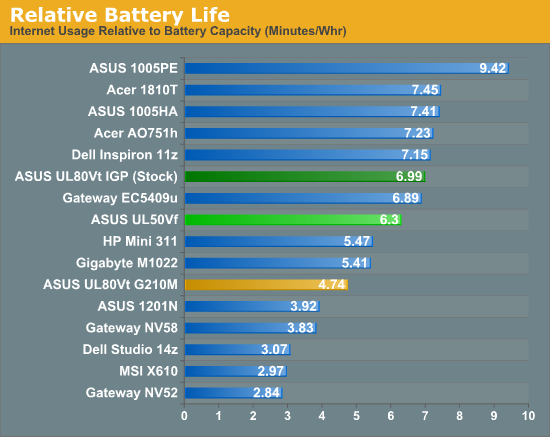
As with the UL80Vt (and all CULV laptops), battery life is a very strong selling point. Putting CULV into a 15.6" chassis and adding a discrete GPU wouldn't be the first choice of most users, however, and here we see the UL50Vf falling behind the UL80Vt. As far as we can tell, the major difference comes down to the LCD, and the result is that the UL80Vt is able to deliver anywhere from 15 (x264) to 215 (idle) minutes more battery life. The Internet test is probably the best overall indication of battery life in common usage scenarios, and even there the 14" UL80Vt delivers 11% more battery life.
This is not to say that the UL80Vt is the better laptop, of course; if the choice is UL50Vf with Optimus or UL80Vt with the second generation switchable graphics, we'd definitely recommend the UL50Vf. However, it does raise the question of why NVIDIA/ASUS would launch the 15.6" model first. Smaller models should follow soon, along with faster, more powerful laptops like the ASUS N61.
NVIDIA's presentation suggests that Optimus allows you to get the best of both worlds: performance as well as battery life. As the test results so far have shown, all of that is possible. However, do keep in mind that you still can't get performance at the same time as long battery life. If you fire up a game on virtually any laptop, even with IGP, battery drain increases substantially. We performed a test of exactly that sort of scenario and the UL50Vf delivered 178 minutes of run time—impressive compared to some larger, faster offerings, sure, but not something you're going to be able to use on a long plane ride or at a LAN party without plugging in.










49 Comments
View All Comments
jfmeister - Tuesday, February 9, 2010 - link
I was anxious to get an mx11 but 2 things were bothering me:1- No DirectX 11 compatibility
2- No Core i5/i7 platform.
Now there is another reason to wait for the refresh. But with arrendale prices droping, DX11 card available, Optimus, I would expect Alienware to get on the badwagon fast for a new mx11 platform and not wait 6 to 8 months for a refresh. This ultra laptop is intended for gamers and we all know that gamers are on top of their things. Optimus in the mx11 case should be a must.
BTW, what I find funny is Optimus looks like a revolution, but what about 3dfx 10 years ago with their 3D Card addon (Monster 3D 8MB ftw)? Swithcing was used back then... This looks like the same thing except with HD video support! It took that long to come up with that?
JarredWalton - Tuesday, February 9, 2010 - link
Remember that the switching back in the days of 3dfx was just in software and that the 3D GPU was always powered. There was the dongle cable situation as well. So the big deal here isn't just switching to a different GPU, but doing it on-the-fly and powering the GPU on/off virtually instantly. We think this will eventually make its way into desktops, but obviously it's a lot more important for laptops.StriderGT - Tuesday, February 9, 2010 - link
My take on Optimus:Optimus roots lie with hybrid SLI.
Back then it was advertised as an nvidia only chipset feature (nvidia IGP + nvidia GPU) for both desktop and notebooks.
Currently nvidia is being rapidly phased out of PC x86 chipsets so optimus is the only way to at least put an nvidia GPU on an intel IGP based system, but:
1. Only real benefit is gaming performance without sacrificing autonomy in notebooks.
2. Higher cost (in the form of the discrete GPU), intel has 60%+ of GPUs(=IGPs) because the vast majority do not care or are uninformed about game performance scaling.
3. CUDA/Physx currently and in the foreseeable future irrelevant for mobile applications (gaming is much more relevant in comparison).
4. Video decoding capabilities already present in most current IGPs (except pinetrail netbooks which can acquire it with a cheaper dedicated chip )
5. Netbooks will not benefit from Optimus because they lack the CPU horsepower to feed the discrete GPU and are very cost sensitive... (same reason that ION1/2 is not the primary choice for netbook builders)
6. In the desktop space only some niche small form factor PC applications could benefit from such a technology eg an SFF PC would need lesser cooling/noise during (IGP) normal operation and become louder more powerful while gaming (GPU)
7. Idling/2D power consumption of most modern desktop GPUs is so low making the added complexity of a simultaneously working onboard IGP and the associated software a no benefit approach.
8. Driver/application software problems that might arise from the complexity of profiles and the vastly different workload application scenarios.
So in the end it boils down how can nvidia convince the world that a discrete GPU and its added cost is necessary in every portable (netbook and upwards sized) device out there. As for the desktop side it will be even more difficult to push such a thing with only noise reduction in small form factor PCs being of interest.
BTW At least now the manufacturers won't have anymore excuses for the lack of descent GPU inside some of the cheaper notebook models (500-1000$), because of battery autonomy reasons.
Oh well I'll keep my hopes low after so much time being a niche market since they might find some other excuse along the lines weight and space required for cooling the GPU during A/C operation... :-(
PS Initially posted on yahoo finance forum
Zoomer - Tuesday, February 9, 2010 - link
Not like it was really necessary; the Voodoo 2 used maybe 25W (probably less) and was meant for a desktop use.jfmeister - Tuesday, February 9, 2010 - link
Good point! I guess I did not take the time to think about it. I was more into the concept than the whole techincal side of that you brought up.Thanks!
JF
cknobman - Tuesday, February 9, 2010 - link
Man mx11 was biggest disappointment out there. weak sauce last gen processor on a so called premium high end gaming brand? Ill consider it once they get an arrandale culv and optima cause right now looking at notebookreview.com forums it is a manual switching graphics not optima.crimson117 - Tuesday, February 9, 2010 - link
Which processor should they have used, in your opinion?cknobman - Tuesday, February 9, 2010 - link
Should have waited another month to market and used the Core i7 ulv processors. There are already a few vendors using this proc (panasonic is one).Wolfpup - Tuesday, April 20, 2010 - link
Optimus is impressive software, but personally I don't want it, ever. I don't want Intel graphics on my CPU. I don't want Intel graphics in my memory controller. I don't want Intel graphics. I want my real GPU to by my real GPU, not a helper device that renders something that gets copied over to Intel's graphics.I just do not want this. I don't like having to rely on profiles either-thankfully you can manually add programs, but still.